Welcome
to the definitive Chrysler 2.2, 2.5 Non-turbo upgrade database.
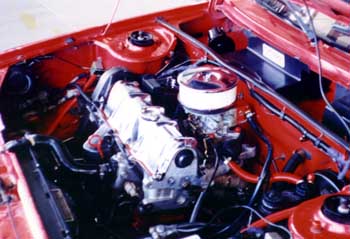 Please,
if you have anything you wish to add to this database e-mail me!
This page is for those looking to upgrade their Chrysler TBI or Carbureted
automobile.
Please,
if you have anything you wish to add to this database e-mail me!
This page is for those looking to upgrade their Chrysler TBI or Carbureted
automobile.
 A big thanks to
these people that contributed to this database!
Angleo Taylor, Bradley
Miller, Cliff Sebring and Tom Byrne.
See links to their websites
at the bottom of the page.
A big thanks to
these people that contributed to this database!
Angleo Taylor, Bradley
Miller, Cliff Sebring and Tom Byrne.
See links to their websites
at the bottom of the page.
A normally
aspirated engine will generally make less power than a force inducted one
(turbo or supercharged). Your best bet, if you have the cash, is
to swap over to a factory turbo setup. If you cannot, then you have
to live with this limitation and make do with the information on this page..
And
if you don't have a healthy motor you're wasting your time.
Exhaust
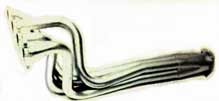 A
factory exhaust manifold is fine for most applications. A good cleanup
with a Dremel tool can't hurt here. A header should only be used
for full race applications. It is very impractical for street use,
and generally has a short life.
Some notes from Angelo Taylor...
..these headers are
so long on the four door that sometimes they actually hit the track from
rocking of the motor on
launch, almost always they hit the cross member..
..in under 1 year of street
action they tend to break at the point where they are
welded at the flange..
..The hot ticket is
to get the Mexican stock exhaust header.....it is a tubular one that uses
the
stock donut and attaching
as do ours..
..Another thing on exhaust,
my car always ran a bit
quicker with some type of exhaust on it
compared to open header..
If you
have the money, get a custom 2 1/4" or 2 1/2" system made up with a very
free flowing muffler and cat. If your area allows it or you are using
your car for off road use only, pitch the cat.
Bradley Miller notes..
...I went with 2 1/2
on the Shelby and it picked it up enough that my screwed up feedback carb
caused a lean/bucking condition...
A word on thermal wraps.
I haven't used them on a non-turbo
application, but on my turbo cars we had wrapped the exhaust manifold.
Now Thermo-Tec notes this is a bad thing and they are correct. It
results with a warped, cracked exhaust manifold that flexes so much it
snapped the #1 exhaust stud right out of the head.
proceed at your own risk...
A
factory exhaust manifold is fine for most applications. A good cleanup
with a Dremel tool can't hurt here. A header should only be used
for full race applications. It is very impractical for street use,
and generally has a short life.
Some notes from Angelo Taylor...
..these headers are
so long on the four door that sometimes they actually hit the track from
rocking of the motor on
launch, almost always they hit the cross member..
..in under 1 year of street
action they tend to break at the point where they are
welded at the flange..
..The hot ticket is
to get the Mexican stock exhaust header.....it is a tubular one that uses
the
stock donut and attaching
as do ours..
..Another thing on exhaust,
my car always ran a bit
quicker with some type of exhaust on it
compared to open header..
If you
have the money, get a custom 2 1/4" or 2 1/2" system made up with a very
free flowing muffler and cat. If your area allows it or you are using
your car for off road use only, pitch the cat.
Bradley Miller notes..
...I went with 2 1/2
on the Shelby and it picked it up enough that my screwed up feedback carb
caused a lean/bucking condition...
A word on thermal wraps.
I haven't used them on a non-turbo
application, but on my turbo cars we had wrapped the exhaust manifold.
Now Thermo-Tec notes this is a bad thing and they are correct. It
results with a warped, cracked exhaust manifold that flexes so much it
snapped the #1 exhaust stud right out of the head.
proceed at your own risk...
Intake
TBI:
Work with what you have, it's all you can get. A good clean up with
a Dremel tool to take the rough edges off can't hurt.
Cliff Sebring sent
me a tip...
The carbureted intake
flows better than the TBI one. I had a customer who was running a TBI setup
who adapted a carb intake
to his TBI unit and it went faster.
I'm
checking into the possibility of a spacer under the TBI unit for better
airflow.
Carb:
The 86-up Intake manifolds are the best for general use.
I am
also looking into information on carb spacers.
I had one made of
wood that did not really seem to do anything.....
Mopar
Performance has a dual carb intake as well as a sidedraft Weber setup.
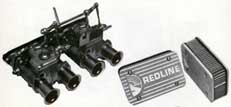 Weber
intake PN: P4349086
...the dual
40 DCOE Weber side draft carbs picked up my car from .75 to around a full
second...
Weber
intake PN: P4349086
...the dual
40 DCOE Weber side draft carbs picked up my car from .75 to around a full
second...
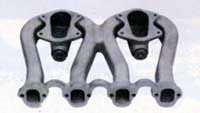 PN:
P4452037
I don't
have any information on the dual carb setup above but will make inquiries.
Note:
this product has been discontinued.
PN:
P4452037
I don't
have any information on the dual carb setup above but will make inquiries.
Note:
this product has been discontinued.
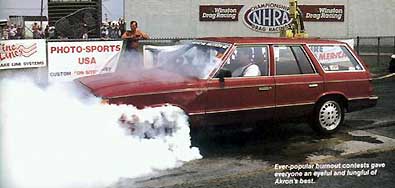 Fred Greer's dual
carbed K-car wagon.
One
easy hp gain is disconnecting the coolant lines running under the
intake for a cooler intake charge. This may cause drivability problems
in cool weather.
You
could also try running water under the intake for an even cooler intake
charge using an electric water pump and a cool can.
Fred Greer's dual
carbed K-car wagon.
One
easy hp gain is disconnecting the coolant lines running under the
intake for a cooler intake charge. This may cause drivability problems
in cool weather.
You
could also try running water under the intake for an even cooler intake
charge using an electric water pump and a cool can.
Camshaft
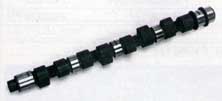 The
best factory cam would be the 84-87 2.2/2.5 camshaft. It has the
most lift and duration of all the non turbo cams. You can run the
later roller cams if you wish; they do have a little smoother idle and
make less noise but you will lose some duration (240 vs 234). It's
a drop in; just use the roller followers and it will work in any 2.2/2.5
engine.
Non
stock cams may also annoy the computer on TBI applications.
..I suggest a 460/480
lift....any easily available duration.....cam sprocket is another thing...
....the 110 HP HO carb cars
had a cam cog that was 2 degrees different than that of the
regular carb 2.2s......the
visual indication is that the hole on the timing point of the cog is oval
instead of circular..
Tom
Byrne writes into the database...
I run the Mopar Performance
252 cam and it runs great. My car is a 2168 lb 84 Shelby Charger that
is raced SCCA SOLO II class.
Carb is a 5220 Holley, compression is 10:1, head is ported with stock valves
and a 3 angle valve job. Exhaust is a stock manifold with 2 1/2" pipe,
and a Flowmaster race muffler (Straight through design) which exits out
just behind the drivers door.
Pn:
P4529320 Specs: 252-252 duration, 430 lift.
NOTE:
Do NOT use the turbo cams in a non turbo application!! You will lose
horsepower. They have less duration and overlap than their non turbo
cousins.
The
best factory cam would be the 84-87 2.2/2.5 camshaft. It has the
most lift and duration of all the non turbo cams. You can run the
later roller cams if you wish; they do have a little smoother idle and
make less noise but you will lose some duration (240 vs 234). It's
a drop in; just use the roller followers and it will work in any 2.2/2.5
engine.
Non
stock cams may also annoy the computer on TBI applications.
..I suggest a 460/480
lift....any easily available duration.....cam sprocket is another thing...
....the 110 HP HO carb cars
had a cam cog that was 2 degrees different than that of the
regular carb 2.2s......the
visual indication is that the hole on the timing point of the cog is oval
instead of circular..
Tom
Byrne writes into the database...
I run the Mopar Performance
252 cam and it runs great. My car is a 2168 lb 84 Shelby Charger that
is raced SCCA SOLO II class.
Carb is a 5220 Holley, compression is 10:1, head is ported with stock valves
and a 3 angle valve job. Exhaust is a stock manifold with 2 1/2" pipe,
and a Flowmaster race muffler (Straight through design) which exits out
just behind the drivers door.
Pn:
P4529320 Specs: 252-252 duration, 430 lift.
NOTE:
Do NOT use the turbo cams in a non turbo application!! You will lose
horsepower. They have less duration and overlap than their non turbo
cousins.
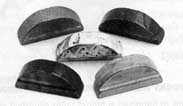 Cam
keys are a good way to adjust your cam timing.
Shelby
retarded the camshaft 4 degrees in the carburated Shelby Chargers
to make
more high rpm hp.
I prefer
cam keys to "slip-slide" cam sprockets because of cost and its easier to
duplicate results with the cam keys.
PN:
P4349650
Cam
keys are a good way to adjust your cam timing.
Shelby
retarded the camshaft 4 degrees in the carburated Shelby Chargers
to make
more high rpm hp.
I prefer
cam keys to "slip-slide" cam sprockets because of cost and its easier to
duplicate results with the cam keys.
PN:
P4349650
Heads
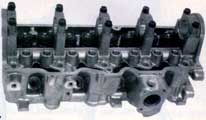 The best flowing head is the
83-85 "G" casting head. It flows 10% more air than the 86-92 "782"
head which makes about 10% more torque. The "G" head would be a good
choice for a light car, while the "782" or fast burn head will be better
for a heavier vehicle.
Porting and polishing of cylinder
heads is best done by a professional. Unless you have lots of practice
and have done several, it's very easy to damage a head and make it unusable.
Mopar Performance has two
heads in their catalog: a mild ported head with 1 mm oversize valves and
a more extensively ported head with much larger valves. I will try
to get some hp numbers to see how much gain is acquired installing one
of these units.
....I
had a big valve head that was ported and 14/1 compression.....my car runs
quicker with the
stock valved head with a
three angle valve job and 12/1 compression and port matching...
....these cars like
efficiency of flow, not mass of flow on the heads..
LRE and Forward Motion
also have ported heads for sale.
The best flowing head is the
83-85 "G" casting head. It flows 10% more air than the 86-92 "782"
head which makes about 10% more torque. The "G" head would be a good
choice for a light car, while the "782" or fast burn head will be better
for a heavier vehicle.
Porting and polishing of cylinder
heads is best done by a professional. Unless you have lots of practice
and have done several, it's very easy to damage a head and make it unusable.
Mopar Performance has two
heads in their catalog: a mild ported head with 1 mm oversize valves and
a more extensively ported head with much larger valves. I will try
to get some hp numbers to see how much gain is acquired installing one
of these units.
....I
had a big valve head that was ported and 14/1 compression.....my car runs
quicker with the
stock valved head with a
three angle valve job and 12/1 compression and port matching...
....these cars like
efficiency of flow, not mass of flow on the heads..
LRE and Forward Motion
also have ported heads for sale.
The
Short Block
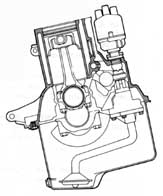 I'm
not going to get into much detail about the various rod/crank/piston combos
that could have been had over the years in the 2.2/2.5 family. Instead
this will be a general tips section on what to do while playing around
the insides of your short block.
It
bears repeating, a healthy motor makes hp- a tired one will not.
If you
have the money and are using your car for pure racing 12.5 to 14:1 compression
seems to be the hot ticket. High-octane race gas of course is required.
For
street use, no more than 9.5:1 is recommended.
Aftermarket
pistons are readily available from TRW, Mopar Performance and J&E Pistons.
Stock
connecting rods are fine, replace the rod bolts with ARP units if
you're having the rods resized (shotpeening is not a bad idea either).
On
oil pressure, experts recommend 7 to 10 psi of oil pressure for every 1000
rpm of engine usage.
7 psi
+ 6000 rpm = 42 psi
10 psi
+ 6000 rpm = 60 psi
Also
make sure you're using Mobil One oil- a synthetic motor oil will make more
hp than a regular oil (frictional gains).
Speaking
of oil, a good baffled oil pan can help keep the oil in the pan where it
belongs. Without one, the crank whips the oil up and costs hp.
On
a 440 Mopar V8 this is good for 15hp at 6000 rpm!
I'm
not going to get into much detail about the various rod/crank/piston combos
that could have been had over the years in the 2.2/2.5 family. Instead
this will be a general tips section on what to do while playing around
the insides of your short block.
It
bears repeating, a healthy motor makes hp- a tired one will not.
If you
have the money and are using your car for pure racing 12.5 to 14:1 compression
seems to be the hot ticket. High-octane race gas of course is required.
For
street use, no more than 9.5:1 is recommended.
Aftermarket
pistons are readily available from TRW, Mopar Performance and J&E Pistons.
Stock
connecting rods are fine, replace the rod bolts with ARP units if
you're having the rods resized (shotpeening is not a bad idea either).
On
oil pressure, experts recommend 7 to 10 psi of oil pressure for every 1000
rpm of engine usage.
7 psi
+ 6000 rpm = 42 psi
10 psi
+ 6000 rpm = 60 psi
Also
make sure you're using Mobil One oil- a synthetic motor oil will make more
hp than a regular oil (frictional gains).
Speaking
of oil, a good baffled oil pan can help keep the oil in the pan where it
belongs. Without one, the crank whips the oil up and costs hp.
On
a 440 Mopar V8 this is good for 15hp at 6000 rpm!
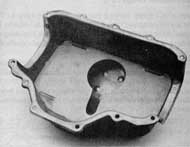 Costs
range from $160 to $400 for a good oil pan.
2.5
liter owners can remove the balance shafts in the oil pan and pickup 10-14
hp for free- they are for secondary order vibrations and not needed.
I have done several turbo and non-turbo cars with no ill effects.
88-95
2.5 Dakotas don't even come with them, no room in the oil pan.
Just
drop the oil pan, remove the 6 bolts holding the balance shafts in, cut
the chain attached to the front of the crankshaft and remove it.
Plug the oil feed hole, which is located next to the number 1 main cap,
with a pipe plug (you will have to tap out the hole), reinstall the oil
pan and your done.
Another
bonus is less engine noise and a pan that holds another quart of oil.
A warning from Cliff...
On
the 2.5 86 to 88 motor swaps you need to install a distributor drive shaft
with a fuel pump
bump {out of your original
2.2} and when you install it you need to put it in 90 deg. out of
time... because the longer 2.5 rod hits the fuel pump bump. On my car I
moved the oil pump 90 deg also, so my distributor was correct but you could
just rotate the wires one hole also...
Of
course this only applies if you are running a carb and wish to use a stock
fuel pump. I would use an electric pump myself...
...note that the oil pump
hole is oval while the one at the surface of the block that it mates to
is round...
..take a die grinder and
make the one on the block match the one on the pump...
...Ed Peters swears there
is a 4 hp gain since pump does not sap as much power due to better oil
flow.....I tried it on my carb Horizon and MAYBE picked up .10...
...not really worth the
effort...
Unless
of course you have the motor apart and have a garage...
every
little bit helps..
Costs
range from $160 to $400 for a good oil pan.
2.5
liter owners can remove the balance shafts in the oil pan and pickup 10-14
hp for free- they are for secondary order vibrations and not needed.
I have done several turbo and non-turbo cars with no ill effects.
88-95
2.5 Dakotas don't even come with them, no room in the oil pan.
Just
drop the oil pan, remove the 6 bolts holding the balance shafts in, cut
the chain attached to the front of the crankshaft and remove it.
Plug the oil feed hole, which is located next to the number 1 main cap,
with a pipe plug (you will have to tap out the hole), reinstall the oil
pan and your done.
Another
bonus is less engine noise and a pan that holds another quart of oil.
A warning from Cliff...
On
the 2.5 86 to 88 motor swaps you need to install a distributor drive shaft
with a fuel pump
bump {out of your original
2.2} and when you install it you need to put it in 90 deg. out of
time... because the longer 2.5 rod hits the fuel pump bump. On my car I
moved the oil pump 90 deg also, so my distributor was correct but you could
just rotate the wires one hole also...
Of
course this only applies if you are running a carb and wish to use a stock
fuel pump. I would use an electric pump myself...
...note that the oil pump
hole is oval while the one at the surface of the block that it mates to
is round...
..take a die grinder and
make the one on the block match the one on the pump...
...Ed Peters swears there
is a 4 hp gain since pump does not sap as much power due to better oil
flow.....I tried it on my carb Horizon and MAYBE picked up .10...
...not really worth the
effort...
Unless
of course you have the motor apart and have a garage...
every
little bit helps..
Ignition
 No
computers are available for the TBI cars. ND Performance is working
on this; a custom computer can be programed for your needs. (505)
458-6024
Computers are available from
Chrysler for carbureted applications.
P4529864 1978-1982
P4529865 ..........1983
P4529866 ..........1984
P4529867 1985-1987
The Mopar Performance
unit does have a good bit of ET improvement over the stock unit....compared
to the 110 HP Shelby unit it has less......in my case (110 hp) the MP unit
was worth initially .5 in
the 1/4 mile..but as air
temperatures rose, the improvement becomes less and less...
...starting out at 50 degrees
it was the 1/2 second improvement, but as the temps hit 80 it leveled off
to the same elapsed times
that I had with the stock unit.....on a non Shelby car the ET would still
be better.
Stock
spark plugs work excellent; RN12YC or for a colder plug, RN9YC.
.35
to .40 gap works just fine, do not go over .40
...I NEVER had luck
with Splitfires or Bosch
Platinums......nothing wrong
with stock Champions.
The
stock ignition coil works great as does the stock (mopar) spark plug wires.
If you
must use aftermarket plug wires get Magnacore wires or make a set
from Moroso spiral core.
Do
NOT use solid core wires! modern computers do not tolerate the
electronic
noise they generate!
No
computers are available for the TBI cars. ND Performance is working
on this; a custom computer can be programed for your needs. (505)
458-6024
Computers are available from
Chrysler for carbureted applications.
P4529864 1978-1982
P4529865 ..........1983
P4529866 ..........1984
P4529867 1985-1987
The Mopar Performance
unit does have a good bit of ET improvement over the stock unit....compared
to the 110 HP Shelby unit it has less......in my case (110 hp) the MP unit
was worth initially .5 in
the 1/4 mile..but as air
temperatures rose, the improvement becomes less and less...
...starting out at 50 degrees
it was the 1/2 second improvement, but as the temps hit 80 it leveled off
to the same elapsed times
that I had with the stock unit.....on a non Shelby car the ET would still
be better.
Stock
spark plugs work excellent; RN12YC or for a colder plug, RN9YC.
.35
to .40 gap works just fine, do not go over .40
...I NEVER had luck
with Splitfires or Bosch
Platinums......nothing wrong
with stock Champions.
The
stock ignition coil works great as does the stock (mopar) spark plug wires.
If you
must use aftermarket plug wires get Magnacore wires or make a set
from Moroso spiral core.
Do
NOT use solid core wires! modern computers do not tolerate the
electronic
noise they generate!
Fault
code charts for Carb and TBI
Carb and TBI
Vacuum
Diagrams for Carb and TBI
84 CARB 85
CARB 86 CARB
85 TBI 86
TBI 87 TBI 88
TBI
Fuel
System: Carb
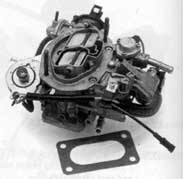 Well,
the plus of running a carburetor is that you can adjust your
fuel curve to your liking.
The down side of course
is that you have to do it yourself!
plus, you lose the
smoothness of fuel injection.
GET
AN O2 GAUGE! ITS THE BEST WAY TO TUNE YOUR CARB!
I
have been using one on my 1970 GTX for over 7 years.
Carb
tuning and rejetting can be done in as little as an afternoon.
There are two basic 2.2
factory carburetors.
The Holley 6520 is a feedback
carb and the 5220 is not.
The 5220 flows a little
more air than the 6520. Caravans, Rampages and 87 2.2 Dakotas came
with the 5220.
The 5220 is also in the
Mopar Performance Catalog. PN: P4286772
I prefer the feedback carb
myself, due to the fact the computer can still adjust your fuel curve at
cruise for best gas mileage.
...the non feed back
carb flows more CFM (I have heard 100) but I do know that the non feed
back carb is better for
bracket racing and consistancy.....it has a power valve that can be
adjusted to open a bit sooner....on
the top of the carb is a tiny metal cap (1/4 dia) that can be
removed and under that is
a hex screw that is directly over the powervalve....simply turn the
screw in one full turn (per
Ed Peters)....or 1/2 turn (per me)......this makes the powervalve open
earlier.....for even better consistancy you would open the carb and plug
off where the
power valve is screwed in.....you
MUST richen up the secondary jetting when you do this.......
Jetting.....I run rather
lean for drag racing with a 225 primary and 335 secondary...
...for next year I will
go to a 355 secondary since I have now removed and pluged the powervalve......for
more power go richer yet.........hint....the old VW (1.7) powered L
bodies had huge secondary
jets in their carbs.....bigger than the jetting kit that is available from
Mopar Performance.
2.2
carb jetting package PN: P4286777
...at one time I put a Holley
500 cfm 2 barrel with mechanical secondary linkage on a 81 Horizon,
it ran absolutely no quicker,
and fuel mileage dropped a lot!!!
We used a 1 1/2" wooden
spacer to mate it to the intake...
Well,
the plus of running a carburetor is that you can adjust your
fuel curve to your liking.
The down side of course
is that you have to do it yourself!
plus, you lose the
smoothness of fuel injection.
GET
AN O2 GAUGE! ITS THE BEST WAY TO TUNE YOUR CARB!
I
have been using one on my 1970 GTX for over 7 years.
Carb
tuning and rejetting can be done in as little as an afternoon.
There are two basic 2.2
factory carburetors.
The Holley 6520 is a feedback
carb and the 5220 is not.
The 5220 flows a little
more air than the 6520. Caravans, Rampages and 87 2.2 Dakotas came
with the 5220.
The 5220 is also in the
Mopar Performance Catalog. PN: P4286772
I prefer the feedback carb
myself, due to the fact the computer can still adjust your fuel curve at
cruise for best gas mileage.
...the non feed back
carb flows more CFM (I have heard 100) but I do know that the non feed
back carb is better for
bracket racing and consistancy.....it has a power valve that can be
adjusted to open a bit sooner....on
the top of the carb is a tiny metal cap (1/4 dia) that can be
removed and under that is
a hex screw that is directly over the powervalve....simply turn the
screw in one full turn (per
Ed Peters)....or 1/2 turn (per me)......this makes the powervalve open
earlier.....for even better consistancy you would open the carb and plug
off where the
power valve is screwed in.....you
MUST richen up the secondary jetting when you do this.......
Jetting.....I run rather
lean for drag racing with a 225 primary and 335 secondary...
...for next year I will
go to a 355 secondary since I have now removed and pluged the powervalve......for
more power go richer yet.........hint....the old VW (1.7) powered L
bodies had huge secondary
jets in their carbs.....bigger than the jetting kit that is available from
Mopar Performance.
2.2
carb jetting package PN: P4286777
...at one time I put a Holley
500 cfm 2 barrel with mechanical secondary linkage on a 81 Horizon,
it ran absolutely no quicker,
and fuel mileage dropped a lot!!!
We used a 1 1/2" wooden
spacer to mate it to the intake...
Mopar Performance
has two carb packages.
One is the downdraft Weber,
which will bolt on your current intake mainifold
and makes good power over
your stocker. PN: P4349300
Note:
this may be a discontinued part number.
The other package is the
Weber sidedraft dual carb and intake kit which makes
max power with a carbureted
2.2/2.5. You will need the inake and two carbs.
PN: P4349086 and P4349087
x2
Mopar Performance recommends
2.5 to 3 psi of fuel pressure for the
Weber sidedraft carburetors.
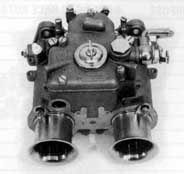 ..the dual 40 DCOE Weber
side draft carbs picked up my car from .75 to around a full second...
...you may need to relocate
the power steering pump for installation (my car was manual)...
..they have a problem with
heat soak from the header,
I suggest a heat shield
be fabricated and placed between the header and the carbs...
...these things have a real
neat sound when run with no air filters!!!
I
had the dual 40mm Webers and that will absolutely make you . . .
well . . . you know . .
when you turn the
key the first time. . .
Touch the throttle and you'll
need an underware change -- it will rev very freely and
quickly. This change
alone is good for about an easy 3/4+ second difference.
Be sure to use a fuel
pressure regulator on the dual 40mm Webers.
If
using the stock style carburetor take a 5/16 fuel filter and put it inline
with your charcoal canister. This will keep chunks of charcoal from
the
canister
out of your float bowl.
An electric
fuel pump will also help prevent vapor lock in hot weather. Chrysler
even had a pump package TSB to repair this problem.
Make
sure to remove the stock pump, block off the fuel pump hole in the block
and use a fuel pump regulator.
..the dual 40 DCOE Weber
side draft carbs picked up my car from .75 to around a full second...
...you may need to relocate
the power steering pump for installation (my car was manual)...
..they have a problem with
heat soak from the header,
I suggest a heat shield
be fabricated and placed between the header and the carbs...
...these things have a real
neat sound when run with no air filters!!!
I
had the dual 40mm Webers and that will absolutely make you . . .
well . . . you know . .
when you turn the
key the first time. . .
Touch the throttle and you'll
need an underware change -- it will rev very freely and
quickly. This change
alone is good for about an easy 3/4+ second difference.
Be sure to use a fuel
pressure regulator on the dual 40mm Webers.
If
using the stock style carburetor take a 5/16 fuel filter and put it inline
with your charcoal canister. This will keep chunks of charcoal from
the
canister
out of your float bowl.
An electric
fuel pump will also help prevent vapor lock in hot weather. Chrysler
even had a pump package TSB to repair this problem.
Make
sure to remove the stock pump, block off the fuel pump hole in the block
and use a fuel pump regulator.
Fuel
System: TBI
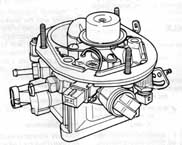 TBI
guys have it the hardest- there is very little you can do to fool around
with
your fuel system.
86-87
cars have the worst computers as they are very limited. They don't
have as much leeway as the 88 and up computers when it comes to injector
size and other parameters...
Here
are some tips and tricks...
Try
an injector from a larger engine (i.e. a 2.5 injector if you have a 2.2).
An adjustable
fuel pressure regulator or pinch valve.
(careful
they only run at 15 psi)
Plug
in a loose coolant sensor (when racing); the computer thinks the engine
is colder than it is, so it richens up the fuel curve.
ND Performance (505 458-6024) makes custom computers.
Call
him with your needs.
TBI
guys have it the hardest- there is very little you can do to fool around
with
your fuel system.
86-87
cars have the worst computers as they are very limited. They don't
have as much leeway as the 88 and up computers when it comes to injector
size and other parameters...
Here
are some tips and tricks...
Try
an injector from a larger engine (i.e. a 2.5 injector if you have a 2.2).
An adjustable
fuel pressure regulator or pinch valve.
(careful
they only run at 15 psi)
Plug
in a loose coolant sensor (when racing); the computer thinks the engine
is colder than it is, so it richens up the fuel curve.
ND Performance (505 458-6024) makes custom computers.
Call
him with your needs.
Fuel
System: Port Fuel Injection
This
here is the deal.
Momma
Mopar never made a PFI non turbo 2.2 in the USA.
They
did however make a 2.5 PFI called the Flexi-Fuel vehicle in 89 or 90.
It was
a spirit that would run on gas or methanol or any combo in between.
It was
used, if memory serves, in a government test fleet in limited numbers.
They
also made/make in mexico a PFI 2.2 combo.
Behold
the only 2.2 PFI non-turbo in the USA!
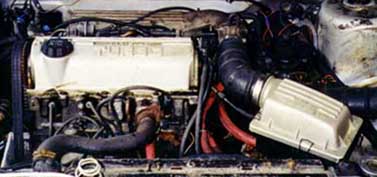 Got
bored one day seeing the Mighty K sitting with no motor in it.
took
a tbi engine that was hiding under a tarp and
slapped
an 89 2.2 turbo intake on it, welded up the egr tube and stuffed it in.
Runs
good but the spark curve is for a turbo car and it takes a dive at WOT.
I have
a custom computer on its way from ND Performance (505 458-6024) and I will
let ya know how it runs this winter.
You
know what they say,
idle
hands are the devils tools!
Got
bored one day seeing the Mighty K sitting with no motor in it.
took
a tbi engine that was hiding under a tarp and
slapped
an 89 2.2 turbo intake on it, welded up the egr tube and stuffed it in.
Runs
good but the spark curve is for a turbo car and it takes a dive at WOT.
I have
a custom computer on its way from ND Performance (505 458-6024) and I will
let ya know how it runs this winter.
You
know what they say,
idle
hands are the devils tools!
Tips
and Tricks
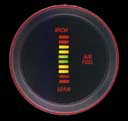 Get
a cyberdyne air/fuel gauge, it makes tuning a snap!
part
number 7009 - it's about $30 from summit racing..
it's
not just for turbos!
If you
have a carbureted car and can get away with it, lose the air pump...
..Couple
of horsepower hiding there.
Weight
is bad -100 lbs is equal to 10 hp or 1/10 sec in the quarter mile.
So you can lose weight or make more power- it's easier to lose weight and
parts last longer. Some examples:
get
a lighter battery (10 lbs), light weight seats (40-90 lbs), lightweight
wheels; empty your trunk-you would be suprised how much weight is lurking
in there; holesaw the bumpers behind the covers where it can't be seen;
pitch the a/c compressor. Hell, if you're desperate scrape the undercoating
off the car.
Now,
if you managed to pull 200 lbs from your car you just gained 20hp.
Simple
isn't it?
Get
a cyberdyne air/fuel gauge, it makes tuning a snap!
part
number 7009 - it's about $30 from summit racing..
it's
not just for turbos!
If you
have a carbureted car and can get away with it, lose the air pump...
..Couple
of horsepower hiding there.
Weight
is bad -100 lbs is equal to 10 hp or 1/10 sec in the quarter mile.
So you can lose weight or make more power- it's easier to lose weight and
parts last longer. Some examples:
get
a lighter battery (10 lbs), light weight seats (40-90 lbs), lightweight
wheels; empty your trunk-you would be suprised how much weight is lurking
in there; holesaw the bumpers behind the covers where it can't be seen;
pitch the a/c compressor. Hell, if you're desperate scrape the undercoating
off the car.
Now,
if you managed to pull 200 lbs from your car you just gained 20hp.
Simple
isn't it?
REPEAT
AFTER ME - THERE IS NO REPLACEMENT FOR DISPLACEMENT
Drop in an 89-up 2.5 in a carbureted car and enjoy the extra ponies.
Just
swap over the intake to a carb model and away you go.
And
remember to pull the balance shafts before installing the engine.
This
can also be done with a TBI car as long as the computer is swapped with
the engine and fuel injector.
86-88
2.5's had a taller deck height so they might be a tighter fit in smaller
cars; plus the exhaust sits up 11mm higher.
Install
a manual transmission if you can and have the tech know how; there are
less hp losses with a manual and you have 2 extra gears to work your powerband
PLUS your gas
mileage goes up as well as the top speed of the car.
Install
a turbo clutch and flywheel; it has a 15mm larger disk and you may never
have to change a clutch again.
A
tip to carb owners using the stock air cleaner setup. Mopar Performance
says to stack 3 gaskets at the air cleaner to carb junction for better
air flow.
Absolute
quickest and cheapest ET gains on these cars, get rid of the air filter
assembly.
Run a ram air hose to the
carb, but make sure you use some sort of fine wire mesh
air filtration. I made a
very tiny screen frame that fit inside the stock air filter assembly, then
plugged all openings to
the air filter box except where the air hose comes from the
computer. That is where
I hooked up the ram air...very easy to do..
Drop
in a 185 degree thermostat for more power, cooler running and better detonation
resistance.
Do not
install a 160 thermostat- excessive wear of the rings will result.
Short
on cash? - get a turbo exhaust system from a junk car of the same model.
Cut the flange off up front, weld on your tbi/carb exhaust flange and it's
a bolt on.
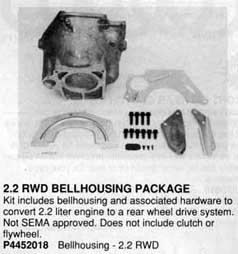 For
those of you considering a RWD conversion...
Mopar
Performance used to have a 2.2/2.5 bellhousing kit in the catalog.
It was
just stock Dakota parts that were bundled in a package.
For
those of you considering a RWD conversion...
Mopar
Performance used to have a 2.2/2.5 bellhousing kit in the catalog.
It was
just stock Dakota parts that were bundled in a package.
Spending
Money
Well,
you can get an underdrive pulley which is good for 10-11hp for $75.
K&N
air cleaners are mandatory equipment. they are cheap and good for
a 1-2% horsepower increase.
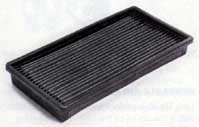 you
may never have to replace an air filter again.
Another
good choice would be a nitrous oxide kit, 50 hp at the touch of a button.
Only problem is when the bottle runs out; but 50hp of juice lasts
a long time.
The
carb part number from NOS systems is: 05011
The
TBI part number is: 05118
note:
I do not know if this is for 84-85 E.F.I.
or 86-92.
you
may never have to replace an air filter again.
Another
good choice would be a nitrous oxide kit, 50 hp at the touch of a button.
Only problem is when the bottle runs out; but 50hp of juice lasts
a long time.
The
carb part number from NOS systems is: 05011
The
TBI part number is: 05118
note:
I do not know if this is for 84-85 E.F.I.
or 86-92.
 714-546-0592
ICE
Nitrous systems used to have a nice kit for the Carb 2.2, but I think
they
are
no longer in business.
714-546-0592
ICE
Nitrous systems used to have a nice kit for the Carb 2.2, but I think
they
are
no longer in business.
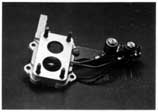 The
part number was: 30023
1-800-845-2383
Mopar Performance used
to list a supercharger for the 2.2 engine (P4349478)
Development work was done
at the Carol Shelby Performance center,
and it was manufactured by
B&M for Chrysler. It was also listed in the B&M catalog,
part number 90601
The
part number was: 30023
1-800-845-2383
Mopar Performance used
to list a supercharger for the 2.2 engine (P4349478)
Development work was done
at the Carol Shelby Performance center,
and it was manufactured by
B&M for Chrysler. It was also listed in the B&M catalog,
part number 90601
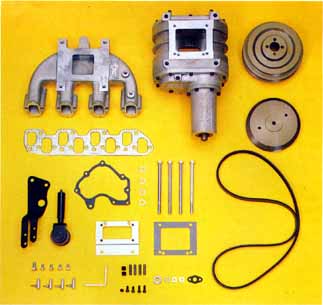 Dealer cost on this in 1987
was $1400!
It made with the stock carb
130hp@5200 RPM.
With the Weber carb (PN P4349300)
the hp jumped to 155@5200 RPM.
Dealer cost on this in 1987
was $1400!
It made with the stock carb
130hp@5200 RPM.
With the Weber carb (PN P4349300)
the hp jumped to 155@5200 RPM.
Links
Angleo
Taylor
Bradley
Miller
Tom
Byrne
Thanks for stopping in!























